Reliable Preservation Solutions for Medical Facilities
A hospital morgue cooler is a specialized refrigeration unit designed to preserve human remains at temperatures between 26C and 46C (35.66F to 39.26F) to slow decomposition and maintain dignity in post-mortem care.
| Hospital Morgue Cooler Quick Facts |
|---|
| Temperature Range: 2-46C (35.6-39.26F) |
| Common Types: Walk-in, body box, portable/pop-up |
| Capacity Options: 2-body to 50+ bodies |
| Standard Features: Stainless steel construction, digital temperature control, vapor-proof lighting |
| Starting Price: Around $6,095 for a standard 2-body unit |
Hospital morgue coolers are essential equipment for any medical facility that handles deceased patients. These specialized refrigeration units ensure proper preservation of human remains while awaiting identification, autopsy, organ donation, or transfer to funeral services.
Modern morgue coolers come in various configurations to meet different facility needs:
- Walk-in coolers - High-capacity storage (4-50+ bodies) with modular, expandable design
- Body box coolers - Compact units (2-12 bodies) that plug into standard outlets
- Portable/pop-up coolers - Temporary or emergency solutions for surge capacity
The quality of a hospital morgue cooler directly impacts a facility's ability to maintain dignity in end-of-life care while meeting strict regulatory requirements from organizations like the FDA, CDC, and OSHA.
I'm with American Mortuary Coolers, a national-level supplier of mortuary refrigeration systems with extensive experience providing hospital morgue coolers to healthcare facilities across the United States. Our expertise includes helping facilities select the right cooling solutions that balance capacity needs, space constraints, and budget considerations.
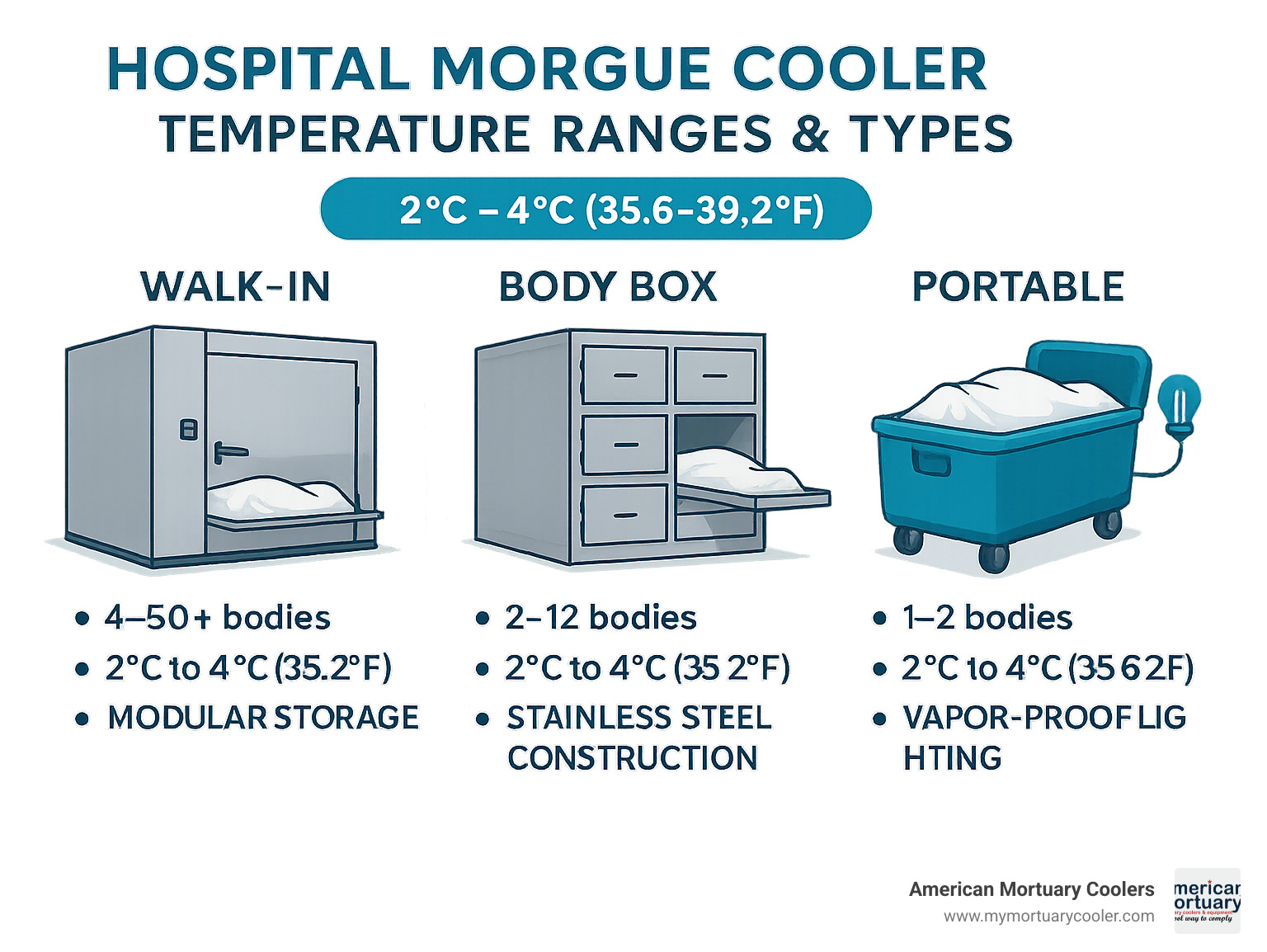
Hospital morgue cooler terms explained:
What Is a Hospital Morgue Cooler and Why Does Every Facility Need One?
When I visit hospitals across the country, one question I'm often asked is: "What exactly is a hospital morgue cooler, and why do we need one?"
Simply put, a hospital morgue cooler is a specialized refrigeration unit designed with one important purpose - to preserve human remains with dignity and respect in a medical setting. Unlike the refrigerator in your kitchen or even commercial refrigeration units, these systems are engineered specifically for the unique and sensitive task of caring for those who have passed.
These coolers maintain a precise temperature environment, typically between 2°C and 4°C (35.6°F to 39.2°F), which significantly slows the natural decomposition process that begins immediately after death. This careful preservation ensures remains stay in a dignified condition while families make arrangements and medical professionals complete necessary procedures.
"Time is precious after a death," as one of our hospital partners recently told me. "A properly functioning hospital morgue cooler gives families the time they need while maintaining the dignity of their loved one."
Every hospital needs some form of morgue refrigeration because it provides essential time for:
- Compassionate family identification and goodbyes
- Completion of required medical documentation
- Thorough autopsy or medical examination when necessary
- Careful organ donation procedures
- Respectful transfer to funeral services
Even smaller facilities that may quickly transfer deceased patients to larger institutions need temporary storage capabilities that maintain dignity and comply with regulations. The reality is that proper care for the deceased is both an ethical responsibility and a regulatory requirement.
Standard Temperature Range Explained
The science behind the standard 2°C to 4°C (35.6°F to 39.2°F) temperature range in a hospital morgue cooler is fascinating and purposeful. This specific range isn't arbitrary - it's carefully calibrated to achieve several important goals.
This "goldilocks zone" of refrigeration significantly reduces bacterial growth and enzymatic activity that drive decomposition without causing freezing damage to tissues. It's cool enough to preserve but not so cold that it causes cellular damage that might interfere with medical examinations or viewings.
The controlled environment also helps contain pathogens while maintaining tissue integrity - particularly important when organ donation might be considered. The preservation of tissues in their natural state is essential for both medical and compassionate reasons.
I've worked with some specialized facilities that require negative temperature units operating between -10°C and -50°C (-14°F to -58°F). These freezer units completely halt decomposition but aren't typically used in standard hospital settings since freezing can cause tissue damage that interferes with certain procedures and viewings.
As a hospital administrator in Texas explained to me, "We chose the standard temperature range because it gives us the flexibility to accommodate both medical needs and family requests with dignity."
How Hospital Morgue Coolers Support Compliance
One aspect of hospital morgue coolers that's often overlooked is how they help facilities steer the complex web of regulatory requirements. These aren't just refrigerators - they're compliance tools that help hospitals meet standards from multiple agencies.
The FDA, CDC, OSHA, and NSF all have guidelines that touch on different aspects of morgue operations. A properly designed cooler helps facilities meet these requirements without additional burden on staff. For example, OSHA mandates safety release handles on all full-size cooler doors - a feature included in every unit we provide.
Energy efficiency is another compliance concern. The Federal Energy Independence & Security Act of 2007 (EISA) Title III, section 312 sets specific standards for walk-in coolers that all modern units must meet. This not only ensures regulatory compliance but also reduces operational costs over time.
Quality hospital morgue coolers include features specifically designed for compliance:
Safety release handles, vapor-proof lighting with exterior switches, digital temperature monitoring systems, and alarms for temperature deviation all work together to create a system that maintains dignity while meeting regulatory requirements.
The antimicrobial surfaces and seamless construction eliminate places where contaminants could collect, supporting infection control protocols. These design elements aren't just good practices - they're essential for meeting CDC guidelines and protecting staff.
As one hospital director told me after installing new coolers, "Having equipment that naturally helps us stay compliant gives us peace of mind and lets us focus on what matters most - caring for patients and their families during difficult times."
Investing in a properly designed hospital morgue cooler ensures that facilities can provide dignified care while confidently meeting all applicable regulatory requirements.
Main Types of Hospital Morgue Coolers on the Market
When it comes to choosing a hospital morgue cooler, facilities have several distinct options, each designed to address different needs, space limitations, and capacity requirements. Understanding these differences helps healthcare facilities make informed decisions that align with their specific operational needs and budget constraints.
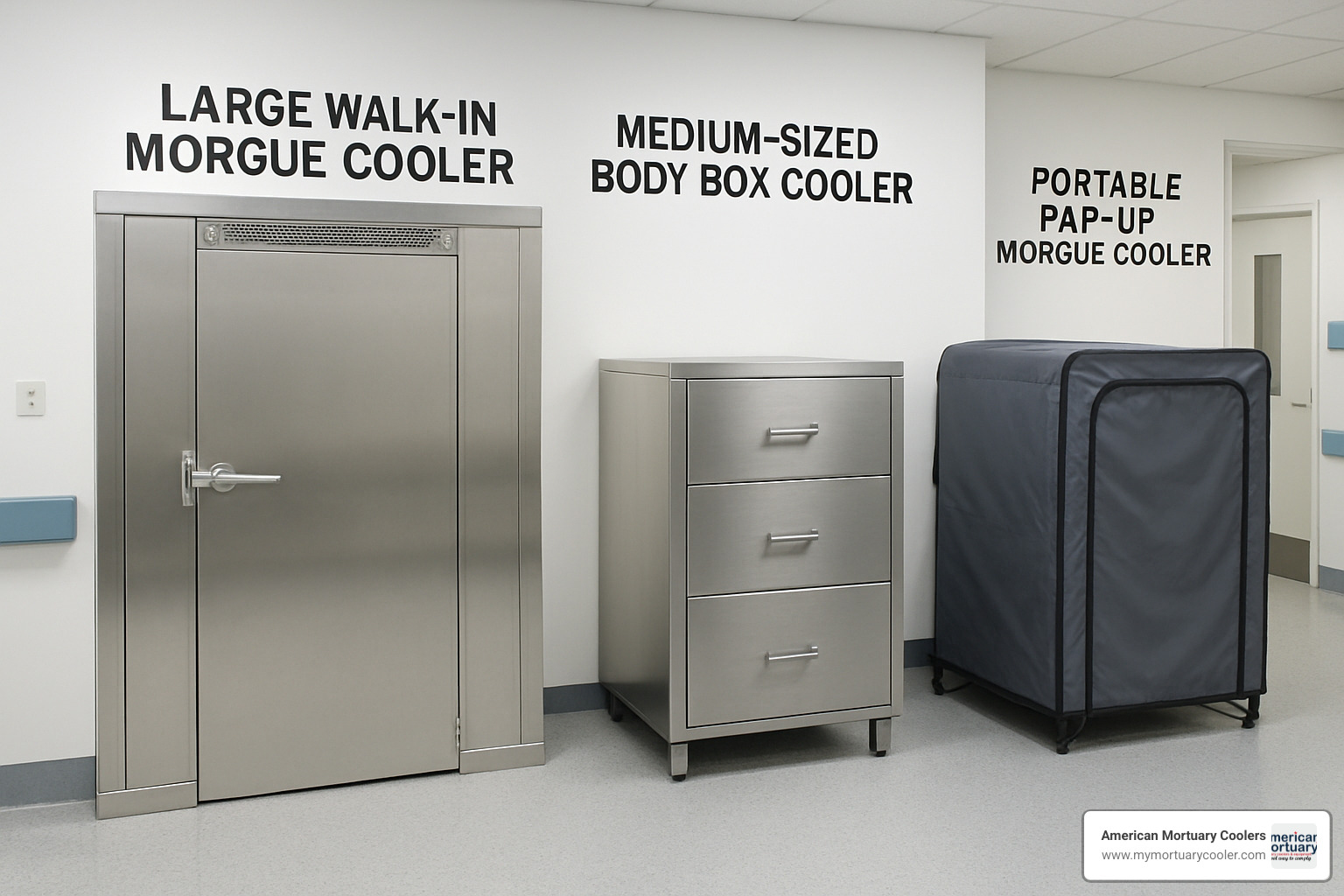
| Type | Capacity Range | Installation | Power Requirements | Best For |
|---|---|---|---|---|
| Walk-In | 4-50+ bodies | Permanent/Modular | 208-230V | Large hospitals, medical examiners |
| Body Box | 2-12 bodies | Semi-permanent | 110-115V | Small-medium hospitals, funeral homes |
| Portable/Pop-up | 4-24 bodies | Temporary | 110-115V | Emergency response, surge capacity |
Walk-In Hospital Morgue Cooler Systems
Think of walk-in hospital morgue coolers as the roomiest option in the morgue refrigeration family. These high-capacity solutions are perfect for busy hospitals and medical examiners' offices where space needs can fluctuate.
What makes these systems special is their flexibility. Built with modular panels that snap together like sophisticated building blocks, these units can be assembled, taken apart, and even expanded as your facility's needs change. One of our clients recently told us, "We started with a 6-body capacity, but within three years, we needed to double it0the modular design made expansion straightforward rather than a construction nightmare."
Walk-in systems offer plenty of interior customization too. You can choose from cantilever racks that maximize floor space, roll-in racks for easier body transfer, or even specialized configurations for particular needs. Door options include space-saving sliding doors, bi-parting doors for wider access, or roll-up doors when floor space is at a premium.
While these units do require more dedicated space and typically run on 208-230V power rather than standard outlets, they offer the most efficient storage per square foot for high-volume facilities. Their digital temperature controls with remote monitoring capabilities also provide peace of mind for staff who need to ensure consistent preservation conditions.
Upright or Body-Box Coolers
Body-box coolers (also called upright coolers) are the versatile middle-ground option in the hospital morgue cooler world. They're perfect for facilities with moderate storage needs or limited floor space.
These self-contained units are essentially plug-and-play solutions1most run on standard 110V power, meaning no special electrical work is required. As one of our smaller hospital clients put it, "We just rolled it in, plugged it in, and we were operational within hours."
Available in various sizes1from compact 2-body models to larger 12-body configurations1these units feature telescoping trays with smooth-gliding extruded aluminum slide rails and nylon rollers. This design ensures respectful, dignified handling of the deceased when transferring or retrieving remains.
The construction quality matters tremendously with these units. Our standard models feature 4-inch closed-cell insulation that maintains temperature efficiently while keeping energy costs in check. The stainless steel exteriors not only look professional but also stand up to rigorous cleaning protocols and disinfectants without deteriorating.
For smaller facilities that don't have room for a dedicated morgue space, these upright coolers offer an excellent solution that can be placed in a variety of locations while maintaining proper temperature control and dignity for the deceased.
Portable & Pop-Up Solutions
Sometimes life throws curveballs, and that's where portable and pop-up hospital morgue coolers shine. These innovative solutions address temporary needs, emergency situations, or facilities with fluctuating capacity requirements.
Imagine being able to set up additional morgue capacity in less than an hour1that's the reality with today's portable solutions. Using lightweight yet highly insulative materials, these units can be rapidly deployed and later stored when not needed, making them perfect for pandemic surges or disaster response.
The AirCool system exemplifies this innovation. As one emergency management director told us, "During our hospital renovation, we needed temporary capacity. The AirCool unit was surprisingly easy to assemble, had convenient A4 pockets for documentation, and featured fully rollered racking that made transfers dignified and simple."
What's particularly impressive about modern portable options is their performance. The AirCool Extreme model, for instance, maintains a steady 56C internal temperature even when ambient temperatures soar to 406C1making it suitable for deployment in challenging environments from desert field hospitals to hurricane response zones.
Many portable units also offer specialized features like bariatric capacity for individuals up to 256 kg/40 st, addressing an important need in today's healthcare environment. Some models have even been adopted for military applications, carrying NATO stock numbers for field hospital deployment.
At American Mortuary Coolers, we understand that every facility has unique needs, which is why we offer customized solutions across all three categories of hospital morgue coolers. Whether you need a permanent walk-in installation, a compact body-box unit, or a flexible portable solution, we deliver directly to all 48 contiguous states, ensuring your facility has the right equipment to maintain dignity and compliance in end-of-life care.
Choosing the Right Hospital Morgue Cooler: Key Specifications & Features
Selecting the perfect hospital morgue cooler is a bit like choosing a new car 1 you need the right combination of features, size, and reliability to meet your needs. Let's walk through the essential elements that make a difference in performance, compliance, and long-term value for your facility.
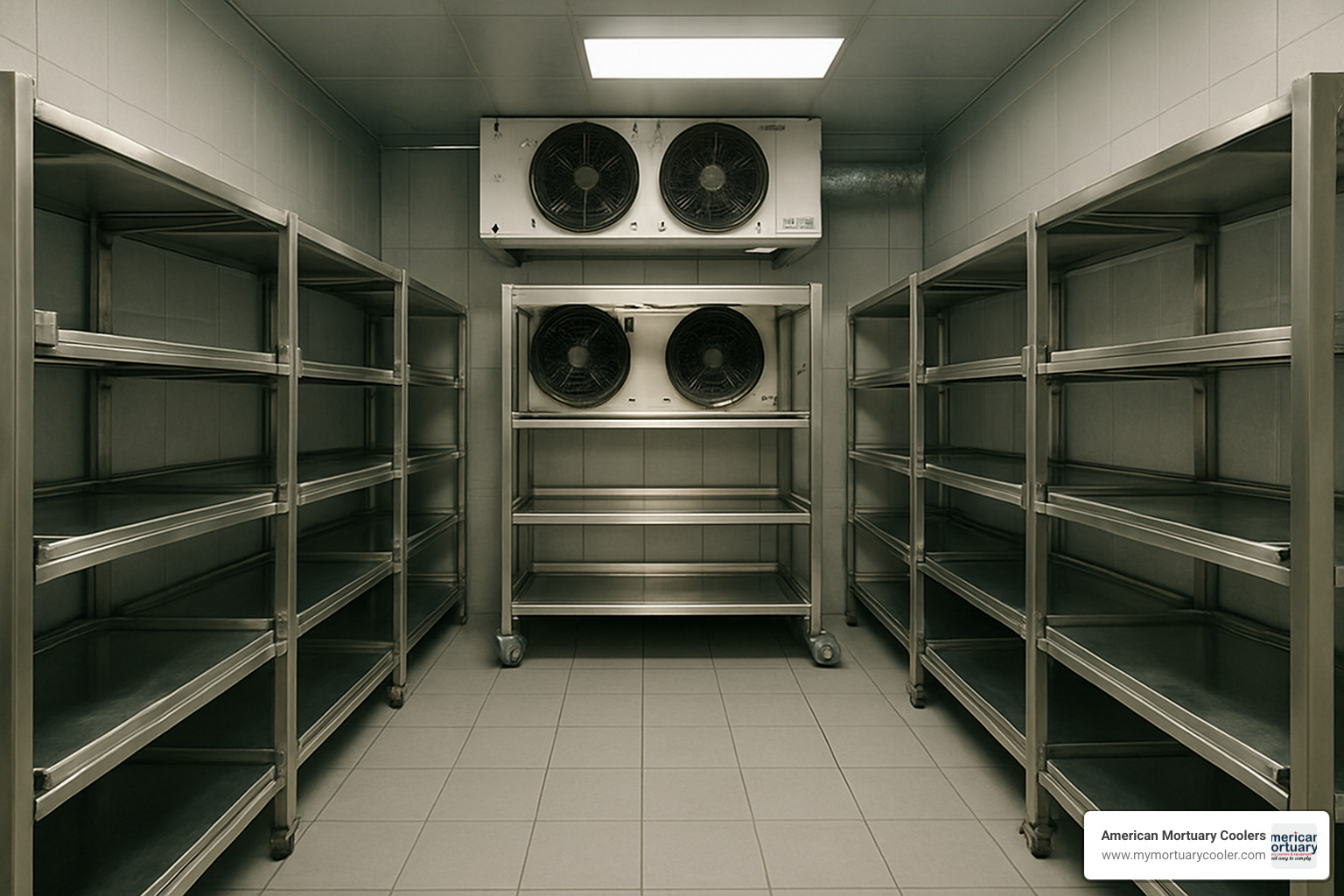
Capacity Planning & Footprint Calculations
When it comes to sizing your hospital morgue cooler, thinking ahead saves headaches later. Start by analyzing your current patient volume, but don't stop there. Consider your community's growth projections and how your facility might expand in the coming years.
Most hospitals find that having some buffer capacity is invaluable during unexpected situations. A standard 2-body cooler typically measures around 7'3" 0 3'3/4" 0 5'2", making it suitable for smaller facilities. For larger operations, a 10-body walk-in system might be more appropriate, though it requires dedicated space with proper clearances.
Interestingly, some models come in "floorless" configurations (like the "AWIC 2 BODY BOX NO FLOOR STANDARD") which can save on materials and simplify installation while reducing costs. This is particularly helpful when installing on existing concrete floors.
For facilities with unpredictable needs, I often recommend modular systems. They're the expandable storage containers of the morgue world 1 start with what you need today and add sections as demand grows. This approach prevents both wasting resources on unnecessary capacity and the frustration of outgrowing your system too quickly.
Temperature Control & Energy Efficiency
The cooling system is truly the heart of any hospital morgue cooler, affecting both performance and your monthly utility bills. When evaluating cooling options, pay attention to the BTUH (British Thermal Units per Hour) rating, which should match your unit's volume and your local climate conditions.
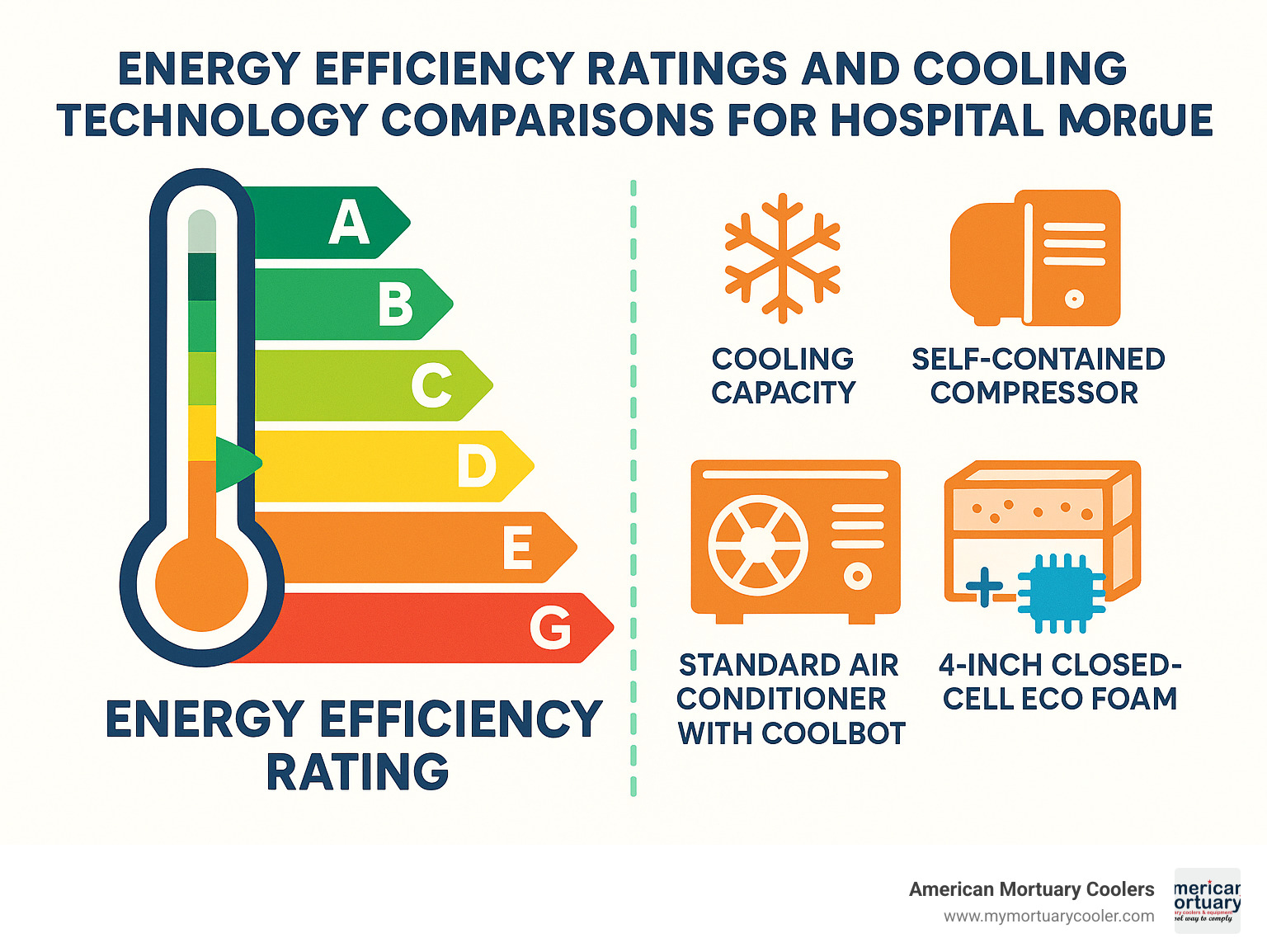
Quality insulation makes a tremendous difference in efficiency. The best units feature 4-inch closed-cell ECO foam that completely fills all gaps, eliminating "hot spots" that can compromise temperature stability. This level of insulation not only maintains consistent cooling but also keeps your energy bills in check.
If your facility is in Phoenix or Miami, pay special attention to your compressor specifications. Many standard units are rated for ambient temperatures up to 956F 1 exceed that, and you might void your warranty unless you've opted for an upsized compressor. I've seen this catch many facilities by surprise during their first summer.
Some innovative cooling alternatives have emerged recently, including CoolBot systems that allow standard air conditioners to achieve morgue-appropriate temperatures. These can be cost-effective options for smaller facilities or temporary solutions.
Look for units compliant with EISA 2007 standards to ensure you're getting an energy-efficient system that meets federal requirements. The initial investment in efficiency typically pays dividends throughout the cooler's lifecycle.
Construction Materials & Sanitation
In hospital morgue coolers, material choices directly impact both durability and infection control. Type 304 stainless steel with a No. 4 finish represents the gold standard for exteriors, offering exceptional resistance to corrosion and ease of cleaning.
Inside the unit, seamless construction with coved corners eliminates nooks and crannies where biological materials could hide. Think of it as the difference between a countertop with grout lines versus a single-piece solid surface 1 one is inherently easier to keep clean.
Some manufacturers have introduced antimicrobial innovations like antibacterial ion powder coatings that actively inhibit pathogen growth on interior surfaces. These treatments add an extra layer of protection beyond regular cleaning protocols.
Floor materials matter too 1 they should be non-porous and resistant to the chemical cleaners used in morgue environments. Gasket quality is another often-overlooked detail; magnetic door seals prevent both temperature loss and potential contamination.
Every joint, seam, or connection represents a potential cleaning challenge. The fewer seams, the better from a sanitation perspective.
Safety & Regulatory Features Checklist
Safety features in a hospital morgue cooler aren't just nice-to-haves 1 many are mandated by organizations like OSHA. Panic release handles that allow opening from inside the cooler are non-negotiable for walk-in units.
Temperature monitoring capabilities have evolved significantly in recent years. Basic digital displays meet minimum requirements, but systems with remote monitoring can alert staff to problems even during off-hours or weekends. Some advanced systems even send alerts directly to staff phones if temperatures drift outside acceptable ranges.
Vapor-proof lighting is standard in quality units, protecting electrical components from moisture while providing adequate illumination for staff. Data logging capabilities, which record temperature history, prove invaluable during regulatory inspections or if questions arise about storage conditions.
Consider third-party certifications like UL/NSF and ISO 9001 as indicators of quality and compliance. These certifications mean the manufacturer has submitted to outside verification of their safety and quality management systems.
When evaluating security features, balance accessibility for authorized staff with preventing unauthorized entry. Electronic access systems can provide both security and an audit trail of who accessed the cooler and when 1 particularly valuable in forensic or research settings.
At American Mortuary Coolers, we've helped hundreds of facilities steer these considerations to find the perfect balance of features, capacity, and value. The right hospital morgue cooler provides peace of mind through reliable performance, regulatory compliance, and dignified care for the deceased.
Installation, Maintenance, and Lifecycle Costs
Let's talk about what it really takes to own a hospital morgue cooler - from the day it arrives at your facility to the years of service it will provide. Understanding these practical aspects helps you plan better and avoid surprises down the road.
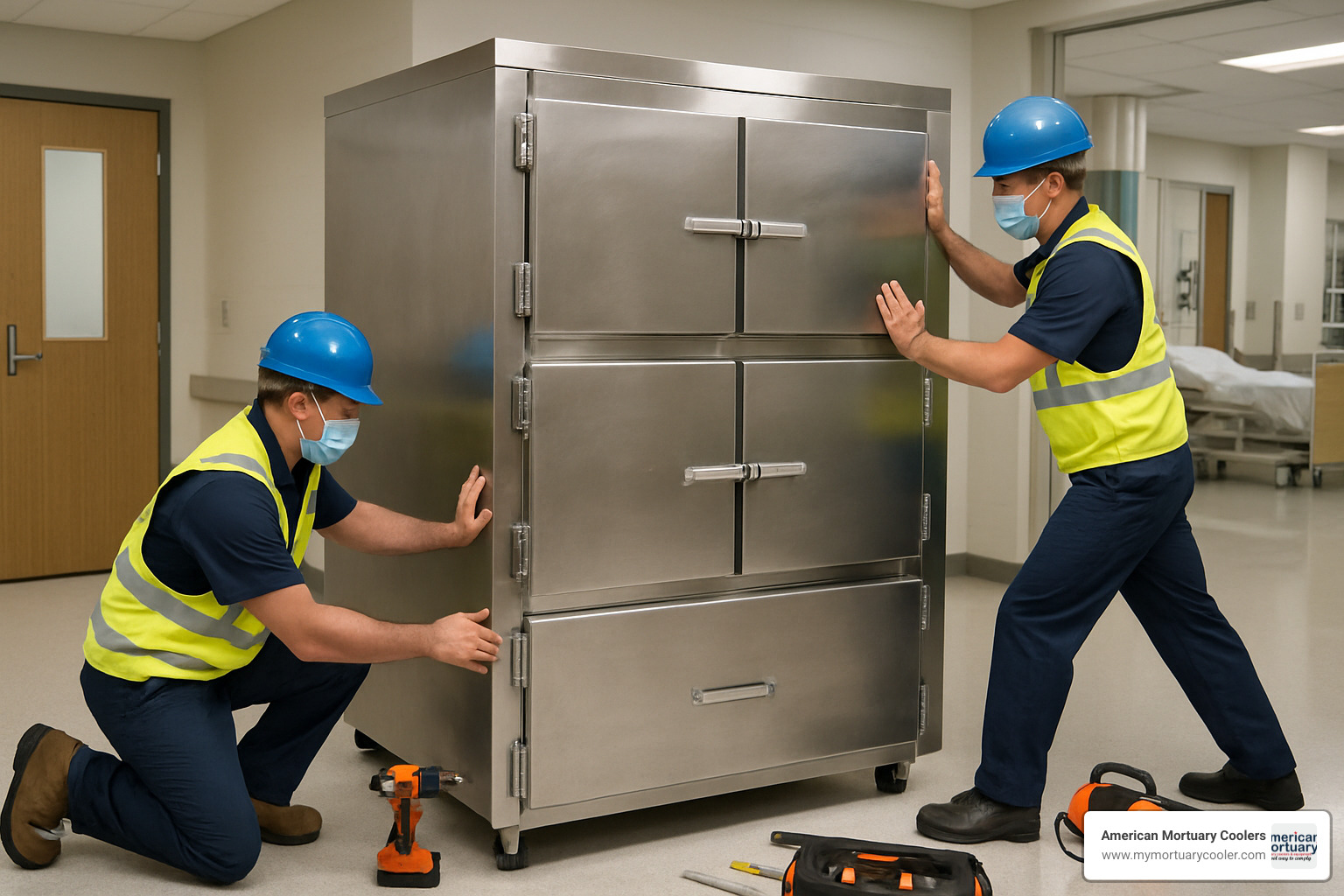
When that delivery truck pulls up with your new hospital morgue cooler, you'll want to be prepared. Most facilities find it's worth the extra $75-100 for lift-gate service, especially for larger units that are simply too heavy to manually unload. Trust me, your maintenance team's backs will thank you!
Installation Considerations
Getting your hospital morgue cooler properly set up is crucial for years of trouble-free operation. Before your unit arrives, make sure you have:
A level floor that can support the weight of the unit plus its contents. Those 4-inch insulated panels may look lightweight, but they're surprisingly substantial when assembled.
The right electrical service ready to go. While smaller body-box units typically run on standard 110V outlets (just plug and play!), larger walk-in systems often require 208-230V service that might need an electrician's touch.
Many of our customers are surprised to learn that most units ship "knockdown" - meaning they require on-site assembly. Don't worry though! The modular design makes this straightforward with basic tools like a cam-lock wrench, power drill, socket wrench, level, rubber mallet, and tape measure.
"I was nervous about assembly at first," one hospital facilities manager told us, "but the instructional video made it simple. Our team had it up and running in an afternoon."
For facilities without handy staff, factory installation services are available, or we can recommend qualified contractors in your area who've installed our units before.
Maintenance Best Practices for a Hospital Morgue Cooler
A well-maintained hospital morgue cooler is like a reliable old friend - always there when you need it. Creating a simple maintenance schedule prevents headaches and extends equipment life:
Daily checks shouldn't take more than a minute - just verify the temperature display matches your requirements and give the door gaskets a quick visual inspection. Many facilities incorporate this into their regular rounds.
Weekly, take a moment to wipe down exterior surfaces with appropriate cleaners and test the alarm system. This simple routine keeps everything looking professional while ensuring safety systems remain functional.
Monthly maintenance should include a closer look at door hardware (those hinges and latches see a lot of use), cleaning condenser coils, and checking refrigerant levels if you have the equipment to do so. If not, this might be a good monthly check for your refrigeration service provider.
"We learned the hard way that skipping coil cleaning leads to inefficiency and eventually compressor failure," shared one maintenance supervisor. "Now it's on our monthly checklist, and our unit runs perfectly."
Consider establishing a maintenance contract with qualified refrigeration specialists. Many of our customers find this provides peace of mind, often extends equipment warranty, and can actually save money compared to emergency service calls.
Documentation isn't just for regulatory compliance - those temperature logs and maintenance records become invaluable troubleshooting tools if issues arise. A simple binder or digital log can save tremendous headaches during inspections or when diagnosing problems.
Operational Costs & Energy-Saving Tips
The day-to-day costs of running your hospital morgue cooler don't have to break the bank. Smart choices can significantly reduce operational expenses:
LED lighting is a no-brainer upgrade if your unit doesn't already have it. These lights use less electricity, generate less heat (meaning your cooling system works less), and typically last years longer than traditional bulbs.
Door gasket maintenance might seem minor, but those rubber seals are your first defense against temperature loss. When they start to crack or lose their magnetic grip, replace them promptly - the energy savings will quickly cover the cost.
Condenser coil cleaning is perhaps the single most important maintenance task for efficiency. Dust-covered coils force your compressor to work harder and run longer, driving up electricity costs and shortening equipment life.
One clever hospital facilities director told us: "We relocated our unit away from the kitchen exhaust path, and our energy usage dropped by nearly 15%. All that warm, greasy air was making the cooling system work overtime."
Most quality hospital morgue coolers come with substantial warranties - typically 15 years on panels and 5 years on mechanical components. This reflects the durability built into these specialized units and provides budgeting predictability for facility managers.
Some smaller facilities have found innovative approaches to reduce costs, such as using the CoolBot system that allows a standard air conditioner to achieve morgue-appropriate temperatures. As one funeral director shared with us: "With the 8'x12' CoolBot Walk In Cooler for about $5K, I've got capacity for twenty-five people... It is literally a game changer in the funeral industry."
At American Mortuary Coolers, we understand that purchasing a hospital morgue cooler is both a significant investment and an essential necessity. That's why we focus on building units that deliver years of reliable service with minimal maintenance requirements - because we know you have more important things to focus on than worrying about your refrigeration equipment.
Customization, Specialty Storage, and Financing Options
When it comes to hospital morgue coolers, one size definitely doesn't fit all. Today's medical facilities have unique needs that require thoughtful solutions rather than off-the-shelf products. At American Mortuary Coolers, we've seen how customization transforms a basic refrigeration unit into a perfectly custom solution for your facility.
Customization Possibilities
Modern hospital morgue coolers can be custom in ways you might not expect. Need your cooler to blend seamlessly with your facility's aesthetic? We offer PMS color matching at no additional charge, allowing your unit to complement existing building exteriors rather than standing out like a sore thumb.
Beyond appearances, functional customizations make a world of difference in daily operations. Many of our clients choose specialized configurations based on their unique circumstances:
Exterior options range from practical stainless steel that withstands heavy cleaning to custom color-matched finishes that integrate with your facility's design scheme. Door configurations can be customized too 1 side-loading for narrow spaces, end-loading for easier access, or wider bariatric options for specialized needs.
Inside is where customization truly shines. Rack systems with telescoping extruded-aluminum slide rails make body handling safer and more dignified, while lighting options like energy-efficient LEDs improve visibility while reducing energy consumption. For facilities concerned about power reliability, we can integrate backup power connections or generator compatibility to ensure continuous operation during outages.
We've even designed specialized units for unique circumstances. One memorable project involved creating a cooler that could accommodate deceased military personnel with full-body armor for Ministry of Defense field hospitals 1 demonstrating that with the right partner, almost any requirement can be addressed.
When to Choose Modular or Portable Units
Sometimes a permanent installation isn't the right answer. In fact, we're seeing growing demand for flexible hospital morgue cooler solutions that can adapt to changing circumstances.
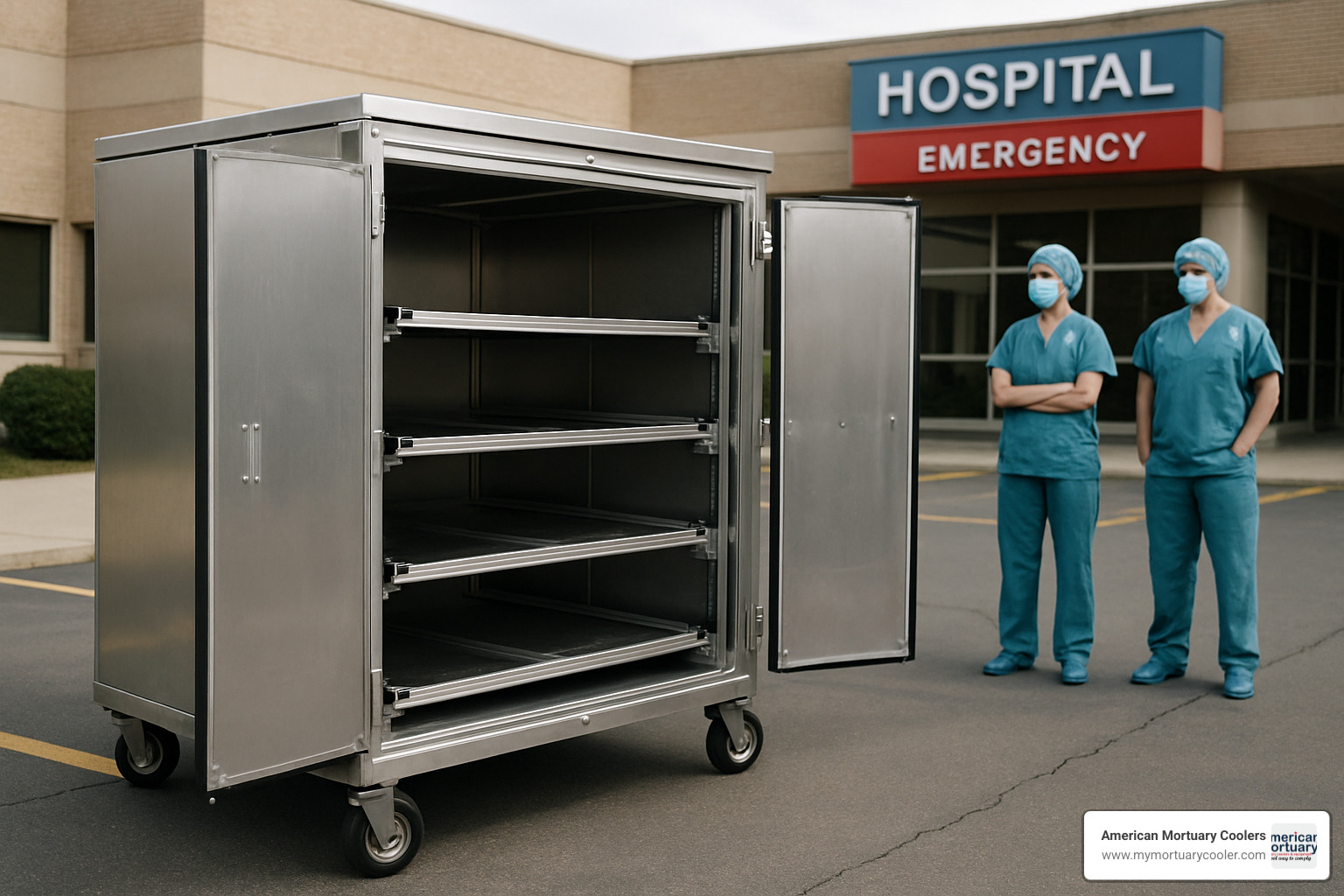
Modular and portable options make perfect sense in several scenarios. During facility renovations, a temporary unit keeps operations running smoothly while your permanent cooler gets upgraded. For areas prone to natural disasters, rapidly deployable units can be lifesavers during mass casualty events. Locations with seasonal population fluctuations 1 like vacation destinations or college towns 1 benefit from capacity that can expand and contract as needed.
The innovative AirCool system exemplifies this flexibility 1 it's essentially a "pop-up mortuary" that can be erected and dismantled within minutes without permanent installation. For hospitals with tight spaces or uncertain future needs, these solutions provide peace of mind without commitment to permanent infrastructure.
Budget constraints often make modular systems attractive too. The ability to implement an expandable system in phases allows facilities to spread costs over time while still planning for future growth. As one of our customers put it: "We started with a basic four-body capacity, but the modular design let us double that three years later without starting from scratch."
Funding Your Hospital Morgue Cooler
Let's be frank 1 a quality hospital morgue cooler represents a significant investment. The good news? You've got options beyond writing a big check upfront.
Traditional capital budgeting works for many facilities, but alternative approaches offer flexibility. Leasing options with fixed-term agreements can transform a large capital expense into manageable monthly payments, often with ownership transfer at the end. For temporary needs, rental solutions provide short-term capacity without long-term commitment.
Many of our clients take advantage of manufacturer financing programs 1 including options with 0% down and no payments for 90 days. This breathing room allows facilities to get equipment installed and operational before beginning payment. For non-profit or rural facilities, healthcare improvement grants sometimes cover essential equipment like morgue coolers.
When evaluating your options, think beyond the initial price tag. A higher-quality unit might cost more upfront but deliver substantial savings through energy efficiency, reduced maintenance needs, and longer service life. One hospital administrator told us: "We almost went with the cheaper option until we calculated the energy savings over ten years 1 the premium unit actually cost less in the long run."
The value of a proper hospital morgue cooler extends beyond dollars and cents. The right system ensures regulatory compliance, improves staff efficiency, and most importantly, provides dignified care for the deceased and comfort for their families during difficult times. These factors, while harder to quantify, are equally important in your decision-making process.
At American Mortuary Coolers, we understand that different facilities have different financial situations, and we're committed to finding a solution that works within your constraints while meeting your needs for quality, reliability, and dignity.
Best Practices for Safe and Sanitary Use
Maintaining a hospital morgue cooler isn't just about the equipment1it's about creating an environment that respects the deceased while protecting the health of your staff. At American Mortuary Coolers, we've helped hundreds of facilities implement protocols that balance dignity, safety, and sanitation.
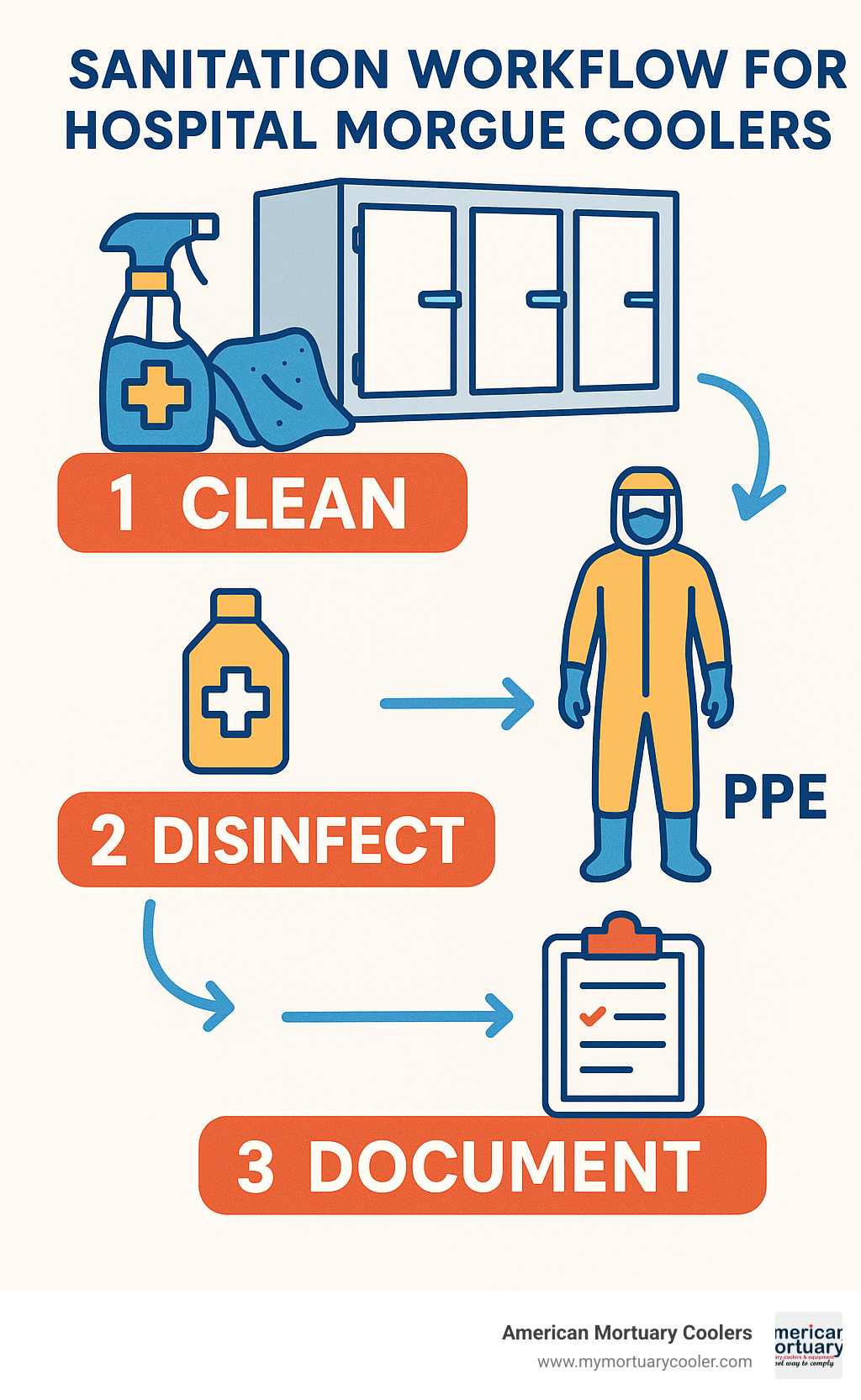
Staff Training and Safety Protocols
The foundation of safe morgue cooler operation begins with comprehensive staff training. Your team should feel confident in their ability to handle every aspect of cooler management, from routine temperature checks to unexpected situations.
Personal protective equipment isn't optional when working with a hospital morgue cooler. Establish clear requirements for gloves, gowns, and face protection appropriate to the task. We often remind our clients that PPE protects not just the handler but also preserves the dignity of the deceased by preventing cross-contamination.
Body handling techniques deserve special attention during training. Proper transfer methods reduce the risk of injury to staff while ensuring respectful treatment of remains. Ground-level coolers eliminate fall risks associated with ramps1a small design detail that makes a big difference in daily operations.
"We provide full staff training and a comprehensive instruction manual with every installation," explains our lead technician. "It's not enough to have great equipment if your team doesn't know how to use it properly."
Documentation might seem like paperwork, but it's actually a critical safety component. Clear chain of custody procedures prevent mix-ups and ensure that each deceased person receives appropriate care. Many of our clients use digital tracking systems that integrate with their existing electronic medical records.
Cleaning and Sanitation
A clean hospital morgue cooler is essential for both health safety and operational efficiency. The good news? High-quality coolers are designed with sanitation in mind.
Hospital-grade disinfectants are your first line of defense, but it's important to choose products compatible with your cooler's materials. Stainless steel interiors can withstand most cleaning agents, while fiberglass units may require gentler approaches. We provide cleaning guidelines specific to each cooler we install.
Spills happen, even in the most careful environments. Having a clear biological fluid containment protocol ensures immediate response when needed. Staff should know exactly where cleanup supplies are stored and how to use them properly.
The seamless construction of our hospital morgue coolers makes cleaning significantly easier. As one of our hospital clients noted, "The coved corners and absence of seams means there's nowhere for contaminants to hide." This design feature isn't just about aesthetics1it's about creating a space that can be thoroughly sanitized.
Many of our newer models include antimicrobial surfaces as an added layer of protection. The anti-bacterial ion powder coating inhibits pathogen growth between cleanings, though we always emphasize that this feature complements rather than replaces regular disinfection.
Dignity and Respect
Technical excellence must always be balanced with compassionate care. A hospital morgue cooler is more than refrigeration equipment1it's a space where families say goodbye and where the deceased deserve continued respect.
Privacy measures start with secure access limited to authorized personnel. Digital locks, manual keypads, or traditional key systems can all work effectively when properly managed. The goal is to create a secure environment where dignity is preserved.
Clear identification systems prevent errors while maintaining respect. Many facilities are moving away from toe tags toward more dignified identification methods that remain with the deceased throughout their time in care.
Religious and cultural considerations matter deeply in end-of-life care. Your hospital morgue cooler protocols should accommodate various faith traditions regarding body positioning, timing of funeral preparations, and family visitation when appropriate.
"At American Mortuary Coolers, we recognize the importance and sensitivity involved in the storage of the deceased," our founder often says. "The technical aspects matter, but never at the expense of treating the deceased with dignity."
When families need to view their loved one, having procedures for dignified presentation makes a difficult moment a little easier. Some facilities create dedicated viewing areas adjacent to their cooler, while others have protocols for temporarily transferring remains to more comfortable spaces.
By implementing these best practices, your facility can maintain the highest standards of safety, sanitation, and respect1creating an environment that honors the deceased while protecting the wellbeing of your staff.
Frequently Asked Questions about Hospital Morgue Coolers
What size hospital morgue cooler do we need?
One of the most common questions we hear from healthcare facilities is about sizing. Finding the right hospital morgue cooler size isn't just about counting current needs – it requires thoughtful planning.
Most smaller hospitals with fewer than 100 beds typically start with a 2-4 body capacity unit, which provides adequate storage while fitting into limited spaces. Mid-size facilities serving 100-300 beds often find that 4-12 body capacity meets their needs, while larger institutions generally require walk-in systems that can accommodate 16 or more bodies.
At American Mortuary Coolers, we've learned from experience that it's wise to plan for about 25% more capacity than your current average needs. This buffer helps during unexpected situations without requiring a rushed emergency purchase. Many of our clients appreciate that our modular systems can grow with them as their requirements change.
Your facility's service area population trends, potential for mass casualty events, available physical space, and budget constraints all play important roles in this decision. We're happy to help you analyze these factors to find the perfect balance for your specific situation.
How often should temperature logs be reviewed?
Temperature monitoring isn't just a regulatory checkbox – it's essential for preserving dignity and maintaining the integrity of the deceased in your care.
Daily temperature checks should be a non-negotiable part of your hospital morgue cooler management. Many of our clients incorporate these checks into their shift handover procedures, creating accountability and ensuring nothing falls through the cracks. These simple daily verifications can prevent significant problems before they develop.
For facilities using systems with continuous recording capabilities, we recommend weekly reviews to identify any concerning patterns or gradual shifts that might indicate developing mechanical issues. These proactive reviews often catch problems before they trigger alarms.
Supervisory staff should also perform monthly audits of temperature logs to verify completion and compliance. These records aren't just internal tools – they're documentation you'll need during health department visits or accreditation reviews.
Digital monitoring systems make this whole process much simpler while providing more reliable documentation. Many of our units feature "remote thermometer" capabilities that allow staff to check temperatures without opening the cooler door, maintaining stable internal conditions.
If your facility uses remote monitoring with alerts, be sure to establish clear protocols for responding to temperature notifications, especially during nights and weekends when staffing may be limited.
Can a hospital morgue cooler be expanded later?
Yes! Many of our clients are pleasantly surprised to learn that modern hospital morgue coolers are designed with future flexibility in mind.
Our modular walk-in systems use prefabricated panels that can be reconfigured or expanded as your needs change. This approach allows you to start with what you need today while having a clear path for growth tomorrow. As one of our manufacturing specialists often explains: "These panels are designed for easy assembly, disassembly, relocation, and expansion without requiring a complete replacement."
Some facilities prefer our stackable body-box units, which can be installed side-by-side as capacity needs increase. This approach works particularly well in spaces with height limitations or where a phased budget approach makes more sense.
For seasonal fluctuations or temporary needs, our portable supplemental units can augment your permanent system during peak periods without requiring permanent expansion.
When planning for potential growth, we recommend ensuring adequate electrical capacity, ventilation, and floor space in your initial installation. Working with our team experienced in phased implementation helps develop a strategic expansion plan that minimizes disruption while controlling costs.
At American Mortuary Coolers, we understand that healthcare facilities' needs evolve over time, and we design our products to grow with you rather than limiting your options down the road.
Conclusion
Choosing the right hospital morgue cooler isn't just about buying equipment - it's about making a decision that touches on dignity, compliance, and operational excellence. Throughout this guide, we've walked through the options, specifications, and practices that can help your facility make choices that serve both today's needs and tomorrow's challenges.
Here at American Mortuary Coolers, we take pride in helping healthcare facilities across the country find refrigeration solutions that truly fit. Based in Tennessee, we've built a nationwide distribution network with centers in Atlanta, Chicago, Dallas, Los Angeles, New York, and regional hubs covering every corner of the country - from the Rocky Mountains to the Southeast coast. This network allows us to deliver custom-crafted coolers to your facility, no matter where you're located.
We understand that a hospital morgue cooler represents more than just a technical purchase. These units play an essential role in providing respectful, dignified care during life's most sensitive moments. That's why we approach every project with both technical precision and genuine compassion for the work you do.
Whether your facility needs a compact 2-body unit for occasional use, a comprehensive walk-in system for a busy medical center, or a portable solution for emergency preparedness, we craft solutions that combine reliability with thoughtful design. Each cooler we build comes with our comprehensive support and industry-leading warranties, because we stand behind our craftsmanship.
Our coolers are built to last, with features that matter - from seamless construction that simplifies cleaning to energy-efficient systems that reduce operational costs. We understand the unique challenges of mortuary refrigeration and design solutions specifically to address those needs.
For facilities planning ahead, our modular systems allow for future expansion without complete replacement. For those facing immediate needs, our nationwide delivery ensures you can quickly implement the solution your facility requires.
For more information about our products and services, or to discuss your specific requirements with our experienced team, we invite you to contact us. Together, we'll ensure your facility has the reliable, efficient, and dignified preservation solution it deserves.
At American Mortuary Coolers, we don't just build refrigeration units - we build peace of mind for healthcare professionals handling life's most sensitive moments.


















